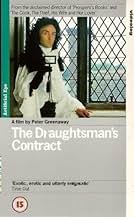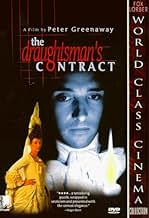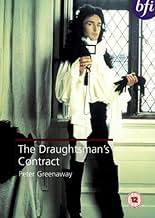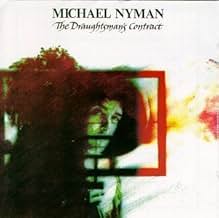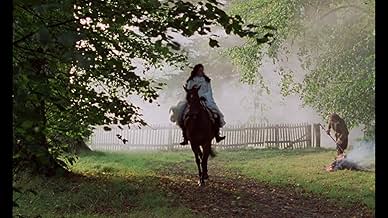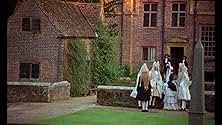AVALIAÇÃO DA IMDb
7,2/10
12 mil
SUA AVALIAÇÃO
A esposa de um rico proprietário de terras encomenda a um jovem artista uma série de desenhos da propriedade enquanto seu marido está fora.A esposa de um rico proprietário de terras encomenda a um jovem artista uma série de desenhos da propriedade enquanto seu marido está fora.A esposa de um rico proprietário de terras encomenda a um jovem artista uma série de desenhos da propriedade enquanto seu marido está fora.
- Direção
- Roteirista
- Artistas
- Prêmios
- 1 vitória e 4 indicações no total
Anne-Louise Lambert
- Mrs. Talmann
- (as Anne Louise Lambert)
Nicholas Amer
- Mr. Parkes
- (as Nicolas Amer)
Lynda La Plante
- Mrs. Clement
- (as Lynda Marchal)
Alastair G. Cumming
- Philip - Mr. Neville's assistant
- (as Alastair Cummings)
Avaliações em destaque
Mr. Neville is a young arrogant artist full of himself. He is contracted to make landscape estate drawings by Mrs. Virginia Herbert. She has a bitter relationship with her wealthy landowning husband who leaves on a trip. She submits to Neville sexually as part of the contract. There is also her daughter Mrs. Talmann and her husband Mr. Talmann. The couple is childless taking care of his nephew. Mrs. Herbert tries to revoke the contract but Neville refuses. Mrs. Talmann blackmails Neville into entering a similar contract pointing out items in his drawings which indicate "misadventure". When Mr. Herbert is found dead in the moat, Neville is horrified to discover that he's the leading suspect.
This is an unusual film. It's a Shakespearian sex romp with a murder mystery. The style has long takes and mid to long distance visuals. The movie lost me the first time around. It can meander and the story can be mercurial. It would help a lot if the murder is shown even if the perpetrators are not. The individual clues need accompanying flashbacks to show that part of the crime. This has a certain amount of beauty and weird originality but it's not easy for everyone.
This is an unusual film. It's a Shakespearian sex romp with a murder mystery. The style has long takes and mid to long distance visuals. The movie lost me the first time around. It can meander and the story can be mercurial. It would help a lot if the murder is shown even if the perpetrators are not. The individual clues need accompanying flashbacks to show that part of the crime. This has a certain amount of beauty and weird originality but it's not easy for everyone.
Is Greenaway our most intelligent filmmaker? One of them at least. He is master of lush self-referential allegory. Here this is hung on a mystery masquerading as restoration comedy. Just maintaining the period and manner is quite a feat.
Self-reference. The film is about an artist who creates rich images that include incongruous elements. The arrogance of the artist is balanced by his blindness as to the meaning, the context of what the images reveal. Both the artist and the viewers are confused by the meaning and flummoxed by the events that the meaning triggers. Greenaway clearly means this to extend to himself, his film and the incompleteness of what we the viewers see. The drawings and the drawer's hands are in fact his.
Fantasy-allegory. This is a film richer in symbology than Drowning and Cook, but probably less so than the later `book' movies. Great attention has been spent on recondite supplementary images, including a central painting in the house being itself painted by the draftsman and filmmaker. I viewed it (the whole film) once just for details. The living statue is only the most obvious illogical element, and in fact draws attention away from other smaller visual diversions.
Mystery artifice. The whole environment is one of genteel artifice, hiding cruel mechanics of conspiracy. The cleverness of the construction is that Greenaway and us are full conspirators. No one, not us, him or the characters shown fully understand what is going on. The mystery form has always been a dialog between artist and consumer, a contest to see who can outwit whom. Very clever use of the mystery form here to include us in the artifice by not ever `playing fair.'
Restoration comedy. Past the visual allegory and the fantasy mystery and the self-reference is a restoration comedy which taken straight is hilarious. The statue is from this form.
My only criticisms are minor. This film contains a restrained story, and incidentally all sex takes place offscreen. Why be so conservative in these areas? Also, Lady Herbert required a more powerful actress I think.
Self-reference. The film is about an artist who creates rich images that include incongruous elements. The arrogance of the artist is balanced by his blindness as to the meaning, the context of what the images reveal. Both the artist and the viewers are confused by the meaning and flummoxed by the events that the meaning triggers. Greenaway clearly means this to extend to himself, his film and the incompleteness of what we the viewers see. The drawings and the drawer's hands are in fact his.
Fantasy-allegory. This is a film richer in symbology than Drowning and Cook, but probably less so than the later `book' movies. Great attention has been spent on recondite supplementary images, including a central painting in the house being itself painted by the draftsman and filmmaker. I viewed it (the whole film) once just for details. The living statue is only the most obvious illogical element, and in fact draws attention away from other smaller visual diversions.
Mystery artifice. The whole environment is one of genteel artifice, hiding cruel mechanics of conspiracy. The cleverness of the construction is that Greenaway and us are full conspirators. No one, not us, him or the characters shown fully understand what is going on. The mystery form has always been a dialog between artist and consumer, a contest to see who can outwit whom. Very clever use of the mystery form here to include us in the artifice by not ever `playing fair.'
Restoration comedy. Past the visual allegory and the fantasy mystery and the self-reference is a restoration comedy which taken straight is hilarious. The statue is from this form.
My only criticisms are minor. This film contains a restrained story, and incidentally all sex takes place offscreen. Why be so conservative in these areas? Also, Lady Herbert required a more powerful actress I think.
Peter Greenaway's first commercially released feature film is a calling card of dazzling virtuosity.
Peter Greenaway's smart, outrageous, and utterly original historic movie is part comedy of manners and part murder mystery, as a late 17th century draughtsman (Anthony Higgins) is tasked with producing a series of drawings for the Herbert family estate by the lady of the manor (Janet Suzan) in order to please her husband, but he ends up pleasing himself with both Mrs Herbert and her daughter (Anne-Louise Herbert), before the husband is found dead in the moat and he becomes prime suspect in his murder. This was Greenaway's first conventional feature film, it shows him at his best and most playful, and is a calling card of dazzling virtuosity. The original cut ran in excess of three hours but was edited down to 103 minutes for release to make it easier to watch. It is still a puzzle box of a movie and a real strange delight though, featuring elaborate and slightly exaggerated (for eye catching effect) period costumes, a wonderful score by Michael Nyman which borrows widely from Henry Purcell, that reflects the period setting whilst managing to rock with a vengeance, and a 'living statue' that roams the garden unseen to all but children, it is a movie that you won't forget in a hurry. Incidentally, Greenaway trained as an artist before he became a filmmaker, and the hands seen drawing in the film are his own, as are the completed drawings.
Guess I really like this sort of period movies, about the British upper-class in the 17th century. The movies have an own unique kind of style and atmosphere over them. This especially really goes for this unique little film.
it's a very witty movie and halve way through it also becomes obvious exactly how intelligently the movie is written and constructed. At first it doesn't look like the movie is heading anywhere and it's merely a good and enjoyable movie filled with some slightly subtle eccentric and quirky characters. But about halve way through it becomes clear that the intentions within the story and the intentions of the characters have way more in to them, when the movie becomes more of a murder-mystery and layered and the character's motivations all start to take form and become clear. It makes the movie surprisingly and delightful. It's a really well constructed and visually crafted movie from Peter Greenaway.
The movie doesn't have the Jane Austen kind of story and approach but more like "Barry Lyndon" with the same certain quirkiness in it, if I need to compare it to anything else. The movie has a sort of a surreal kind of atmosphere over it, which gets strengthened all the more by the outrageous costumes and wigs, thick accents and extremely difficult but beautiful to listen to- dialog and of course the special kind of characters that are in the movie. It's also a very sexy and sort of erotic movie to watch at, with almost always a sort of sexual tension in the atmosphere during the entire movie, despite not having any real nudity or explicit nude scene's in it.
The whole movie is almost entire filmed in a stage-play kind of approach, with no moving camera's and long sequences filled with dialog. Really the sort of stuff you normally experience during a stage-play. It all adds up to the reasons why this movie is a quite unique and delightful little movie to watch.
This movie is a great watch, as long as you're capable of handling the long and difficult dialog and the more stage-play kind of storytelling.
9/10
http://bobafett1138.blogspot.com/
it's a very witty movie and halve way through it also becomes obvious exactly how intelligently the movie is written and constructed. At first it doesn't look like the movie is heading anywhere and it's merely a good and enjoyable movie filled with some slightly subtle eccentric and quirky characters. But about halve way through it becomes clear that the intentions within the story and the intentions of the characters have way more in to them, when the movie becomes more of a murder-mystery and layered and the character's motivations all start to take form and become clear. It makes the movie surprisingly and delightful. It's a really well constructed and visually crafted movie from Peter Greenaway.
The movie doesn't have the Jane Austen kind of story and approach but more like "Barry Lyndon" with the same certain quirkiness in it, if I need to compare it to anything else. The movie has a sort of a surreal kind of atmosphere over it, which gets strengthened all the more by the outrageous costumes and wigs, thick accents and extremely difficult but beautiful to listen to- dialog and of course the special kind of characters that are in the movie. It's also a very sexy and sort of erotic movie to watch at, with almost always a sort of sexual tension in the atmosphere during the entire movie, despite not having any real nudity or explicit nude scene's in it.
The whole movie is almost entire filmed in a stage-play kind of approach, with no moving camera's and long sequences filled with dialog. Really the sort of stuff you normally experience during a stage-play. It all adds up to the reasons why this movie is a quite unique and delightful little movie to watch.
This movie is a great watch, as long as you're capable of handling the long and difficult dialog and the more stage-play kind of storytelling.
9/10
http://bobafett1138.blogspot.com/
The first Peter Greenaway's feature "The Draughtsman's Contract" (1982) - is absolutely delightful, devilishly clever (just imagine the best Agatha Christy's mystery with all sorts of clues and suspects but without Poirot or Ms. Maple to explain in the end whodunit and why. You are on your own to try to figure out - everything you need to know is right there), and funny (Yes, Greenaway can be funny!) art film - the perfect example of an art film. It combines the elements of social satire with murder mystery, meditates on the power of art and role of an artist, studies family drama and mothers -daughters love and understanding, perfectly wraps it in sensual pleasure - and what the pleasure it is. I know I will watch it again because it is a feast for eyes (I've seen big budget movies that looked plain comparing to this one shot on the limited funds), ears (Michael Nyman wrote one of the best score ever for this film) and for brain - there are mysteries and puzzles in every frame and in every dialog.
There is couple of Greenaway's thoughts on his first film and on the films that influenced him from the interview that was published in L'Avant-Scene Cinema", No 333, October 1984:
"Majority of my films may be viewed on several levels. Thus, in "The Draughtsman's Contract" there was the desire to open the symbolism of plants and fruits, to study the connections between the aristocrats and the common people, the conflicts between the worlds of gentlemen and of servants. With my films, I hope to generate interest, to stimulate imagination, to wake feelings...
I consider that 90% of my films one way or another refers to paintings. "Contract" quite openly refers to Caravaggio, Georges de la Tour and other French and Italian artists...
Before the work on the film began, I did not explain to film crew what I wanted, but I showed them five European films: "Fellini's Casanova", "The Last Tango in Paris" by Bertolucci, "The Marquise of O" by Eric Rohmer, "Chronicle of Anna Magdalena Bach" by Jean-Marie Straub and, most importantly, "Last Year at Marienbad" by Alain Resnais which has been the most influential film for me."
There is couple of Greenaway's thoughts on his first film and on the films that influenced him from the interview that was published in L'Avant-Scene Cinema", No 333, October 1984:
"Majority of my films may be viewed on several levels. Thus, in "The Draughtsman's Contract" there was the desire to open the symbolism of plants and fruits, to study the connections between the aristocrats and the common people, the conflicts between the worlds of gentlemen and of servants. With my films, I hope to generate interest, to stimulate imagination, to wake feelings...
I consider that 90% of my films one way or another refers to paintings. "Contract" quite openly refers to Caravaggio, Georges de la Tour and other French and Italian artists...
Before the work on the film began, I did not explain to film crew what I wanted, but I showed them five European films: "Fellini's Casanova", "The Last Tango in Paris" by Bertolucci, "The Marquise of O" by Eric Rohmer, "Chronicle of Anna Magdalena Bach" by Jean-Marie Straub and, most importantly, "Last Year at Marienbad" by Alain Resnais which has been the most influential film for me."
Você sabia?
- CuriosidadesDirector Peter Greenaway, a former art student, created the sketches that feature in the film. In fact the close-up shots of the draughtsman drawing are of his hands.
- Erros de gravaçãoThe cooing of a collared dove is not a sound that would have fallen on Jacobean ears, as the species was unknown in Britain until 1955.
- Citações
Mr. Neville: You must forgive my curiosity, madam, and open your knees.
- Versões alternativasWhen Peter Greenaway screened the movie at festivals in 1982, it ran a full three hours. Included in this footage is a full and further explained rationale for the moving statue.
Principais escolhas
Faça login para avaliar e ver a lista de recomendações personalizadas
- How long is The Draughtsman's Contract?Fornecido pela Alexa
Detalhes
- Data de lançamento
- País de origem
- Idiomas
- Também conhecido como
- The Draughtsman's Contract
- Locações de filme
- Empresas de produção
- Consulte mais créditos da empresa na IMDbPro
Bilheteria
- Orçamento
- £ 320.000 (estimativa)
- Faturamento bruto nos EUA e Canadá
- US$ 2.256.246
- Faturamento bruto mundial
- US$ 2.283.233
Contribua para esta página
Sugerir uma alteração ou adicionar conteúdo ausente

Principal brecha
By what name was O Contrato do Amor (1982) officially released in Canada in French?
Responda



